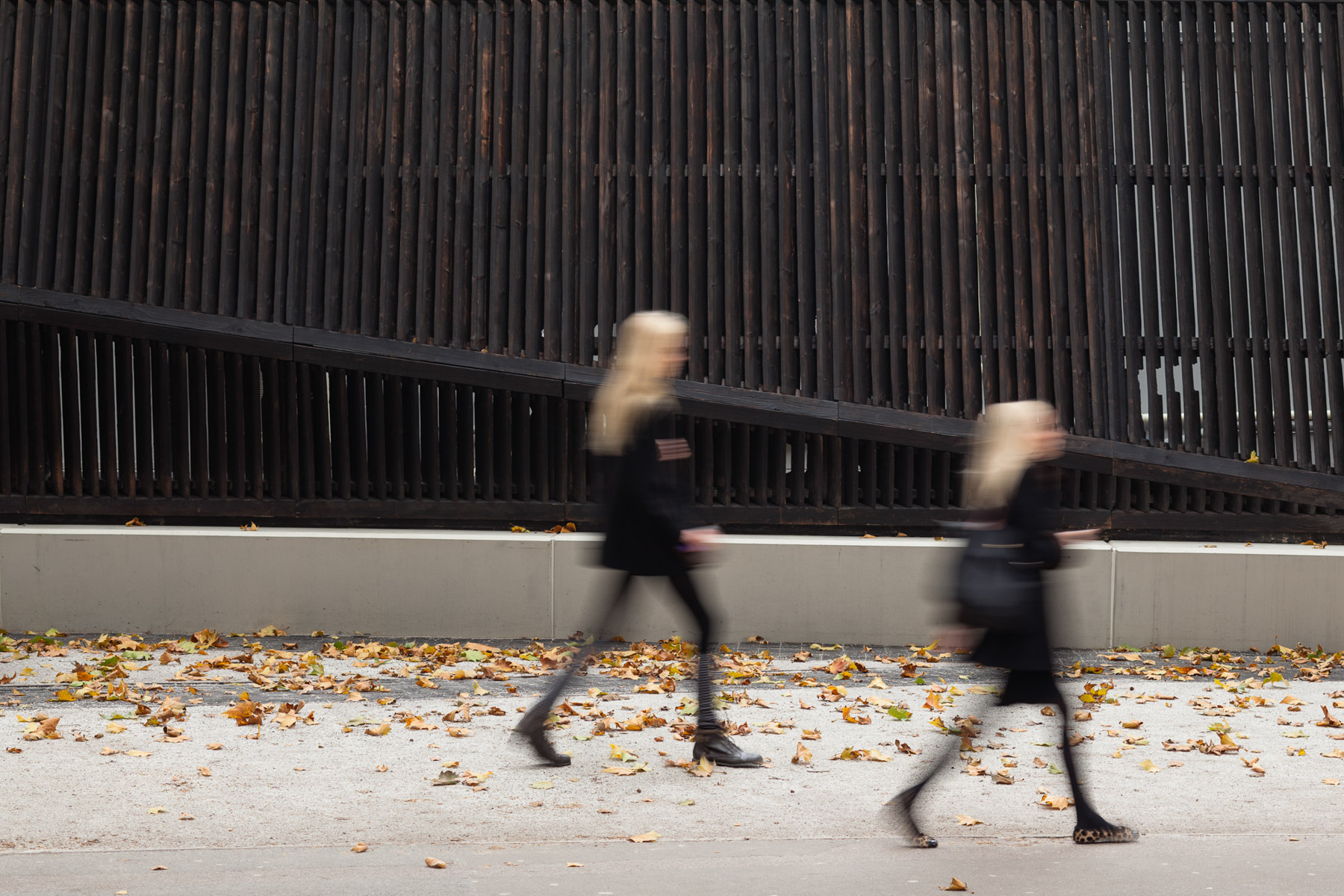2012, London, UK
Skirt Of The Black Mouth
Cast concrete, burnt timber, 6 x 20 x 100 m
Tate Modern, London
Commissioned by Tate Modern, 2012/14



















Commissioned by Tate Modern as a temporary installation during the construction of the gallery’s extension, Skirt of the Black Mouth was a site-specific work that created a new park space, taking an approach to the hoardings that surround building sites by using the boundary as an architectural frame. As with Plaza (see pp. 114–25), the Morisons created a work for a public space that disrupted the rigid grid of the modern city. As before, they used simple folds and cuts to transform monolithic forms, materials, and ideas, to produce a more unexpected, more beautiful geometry. The structure – a blackened louvre fence created with the Japanese technique of scorching timber – was intended to agitate and provoke the viewer; but the artists also want people to find hope through this confrontation. The area between the fence and the road featured paths made with twelve thousand Welsh wooden cobbles.
As Synthia Griffin, the Tate curator who commissioned the work, put it: ‘Skirt of the Black Mouth began as a new approach to the traditional hoarding, using it as a sculptural element to redefine the space, while allowing glimpses of what lies behind. Characterized by a distinctively twisted arrangement of the wall, bench, and path, it is a space stolen back from the construction site, dividing one world from another. Composed of light and dark, silences and shadows, contrasting materials and conflicting ideas, it will encourage visitors to begin to imagine what this space is, and what it might be in the future.’
As Synthia Griffin, the Tate curator who commissioned the work, put it: ‘Skirt of the Black Mouth began as a new approach to the traditional hoarding, using it as a sculptural element to redefine the space, while allowing glimpses of what lies behind. Characterized by a distinctively twisted arrangement of the wall, bench, and path, it is a space stolen back from the construction site, dividing one world from another. Composed of light and dark, silences and shadows, contrasting materials and conflicting ideas, it will encourage visitors to begin to imagine what this space is, and what it might be in the future.’
Sarah Butler, Tate Modern’s writer-in-residence in 2014, described the work in her response to the installation: ‘The Skirt of the Black Mouth is a narrow, uneven triangle of space, reclaimed from the building site of the Tate Modern Project and the adjacent energy plant. A white concrete bench runs along two edges, backed by slats of burnt wood which allow you to see through into the building site. A line of plane trees offers shifting, flickering shade. White chalk boulders dot the space, which is also crossed by two wood-cobbled paths. It is a cut-out space, positioned on the edge of Sumner Street’s curve, almost invisible until you’re upon it.… The Skirt of the Black Mouth is a fiction, a nod to the fragile territory of the same name in Brian Aldiss’s sci-fi novel Hothouse. Aldiss presents an earth – now dominated by aggressive vegetable life – that has stopped turning, and a sun rapidly heading for supernova. It is a place of danger, death and occasional beauty, where the Black Mouth sings its siren song, drawing all living things into its maw.’
‘What are we actually asking artists to do when we commission them to make art in public space? In the case of Skirt of the Black Mouth, commissioned as part of the redevelopment of Tate Modern, it was to temporarily transform a street behind the gallery. But it’s the ideas that Heather and Ivan brought that ignited real change.
Public artworks, they asserted, should disrupt and challenge behaviour; far from creating a place for sanitized interactions, they called for a space of unpredictable encounters. It’s those ideas that still excite me now, long after the work has been dismantled. Monolithic chalk blocks, charred wooden panels running the length of “83 elephants” and wooden cobblestones were the language of their artwork. The materials were tactile and evocative and spoke of wilder spaces, natural landscapes and somewhere imagined. Where better to initiate a deviant act?’
Synthia Griffin, Curator, Tate Modern
‘What are we actually asking artists to do when we commission them to make art in public space? In the case of Skirt of the Black Mouth, commissioned as part of the redevelopment of Tate Modern, it was to temporarily transform a street behind the gallery. But it’s the ideas that Heather and Ivan brought that ignited real change.
Public artworks, they asserted, should disrupt and challenge behaviour; far from creating a place for sanitized interactions, they called for a space of unpredictable encounters. It’s those ideas that still excite me now, long after the work has been dismantled. Monolithic chalk blocks, charred wooden panels running the length of “83 elephants” and wooden cobblestones were the language of their artwork. The materials were tactile and evocative and spoke of wilder spaces, natural landscapes and somewhere imagined. Where better to initiate a deviant act?’
Synthia Griffin, Curator, Tate Modern
Photographers’ credits
Tate installation images_Wig Worland / All other images_Ivan Morison
Tate installation images_Wig Worland / All other images_Ivan Morison